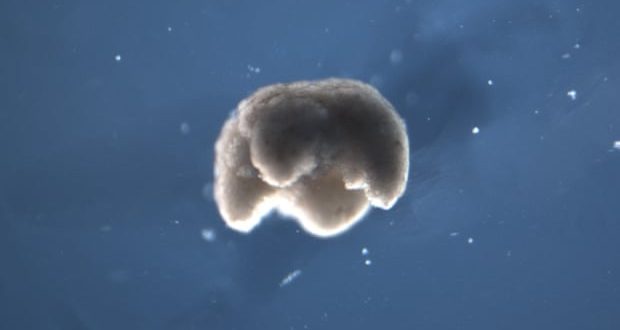Researchers foresee myriad benefits for humanity, but also acknowledge ethical issues
Be warned. If the rise of the robots comes to pass, the apocalypse may be a more squelchy affair than science fiction writers have prepared us for.
Researchers in the US have created the first living machines by assembling cells from African clawed frogs into tiny robots that move around under their own steam.
One of the most successful creations has two stumpy legs that propel it along on its “chest”. Another has a hole in the middle that researchers turned into a pouch so it could shimmy around with miniature payloads.
“These are entirely new lifeforms. They have never before existed on Earth,” said Michael Levin, the director of the Allen Discovery Center at Tufts University in Medford, Massachusetts. “They are living, programmable organisms.”
Roboticists tend to favour metal and plastic for their strength and durability, but Levin and his colleagues see benefits in making robots from biological tissues. When damaged, living robots can heal their wounds, and once their task is done they fall apart, just as natural organisms decay when they die.
Their unique features mean that future versions of the robots might be deployed to clean up microplastic pollution in the oceans, locate and digest toxic materials, deliver drugs in the body or remove plaque from artery walls, the scientists say.
“It’s impossible to know what the applications will be for any new technology, so we can really only guess,” said Joshua Bongard, a senior researcher on the team at the University of Vermont.
The robots, which are less than 1mm long, are designed by an “evolutionary algorithm” that runs on a supercomputer. The program starts by generating random 3D configurations of 500 to 1,000 skin and heart cells. Each design is then tested in a virtual environment, to see, for example, how far it moves when the heart cells are set beating. The best performers are used to spawn more designs, which themselves are then put through their paces.
Because heart cells spontaneously contract and relax, they behave like miniature engines that drive the robots along until their energy reserves run out. The cells have enough fuel inside them for the robots to survive for a week to 10 days before keeling over.
The scientists waited for the computer to churn out 100 generations before picking a handful of designs to build in the lab. They used tweezers and cauterising tools to sculpt early-stage skin and heart cells scraped from the embryos of African clawed frogs, Xenopus laevis. The source of the cells led the scientists to call their creations “xenobots”.
Writing in the Proceedings of the National Academy of Sciences, the researchers describe how they set the robots loose in dishes of water to keep the frog cells alive. Some crept along in straight lines, while others looped around in circles or teamed up with others as they moved around.
“These are very small, but ultimately the plan is to make them to scale,” said Levin. Xenobots might be built with blood vessels, nervous systems and sensory cells, to form rudimentary eyes. By building them out of mammalian cells, they could live on dry land.
Sam Kriegman, a PhD student on the team at the University of Vermont, acknowledged that the work raised ethical issues, particularly given that future variants could have nervous systems and be selected for cognitive capability, making them more active participants in the world. “What’s important to me is that this is public, so we can have a discussion as a society and policymakers can decide what is the best course of action.”
He was less concerned about xenobots posing any threat to humankind. “If you watch the video, it’s hard to fear that these things are taking over any time soon,” he said.
But the work aims to achieve more than just the creation of squidgy robots. “The aim is to understand the software of life,” Levin said. “If you think about birth defects, cancer, age-related diseases, all of these things could be solved if we knew how to make biological structures, to have ultimate control over growth and form.”
The research is funded by the US Defense Advanced Research Projects Agency’s lifelong learning machines programme, which aims to recreate biological learning processes in machines.
Thomas Douglas, a senior research fellow at the Oxford Uehiro Centre for Practical Ethics, said: “There are interesting ethical questions about the moral status of these xenobots. At what point would they become beings with interests that ought to be protected? I think they’d acquire moral significance only if they included neural tissue that enabled some kind of mental life, such as the ability to experience pain.
“But some are more liberal about moral status. They think that all living creatures have interests that should be given some moral consideration. For these people, difficult questions could arise about whether these xenobots should be classified as living creatures or machines.”
The Guardian
 Lebanese Ministry of Information
Lebanese Ministry of Information



